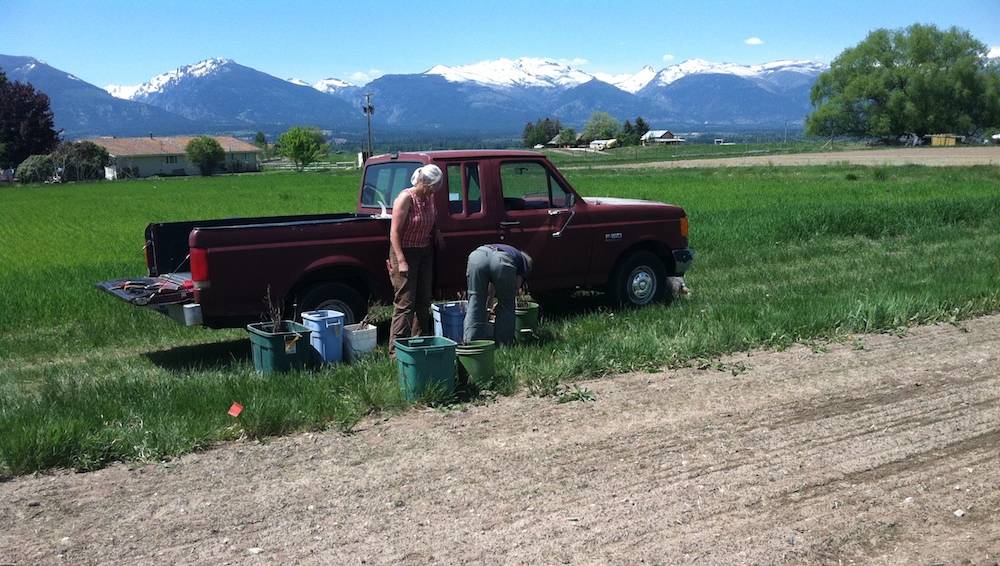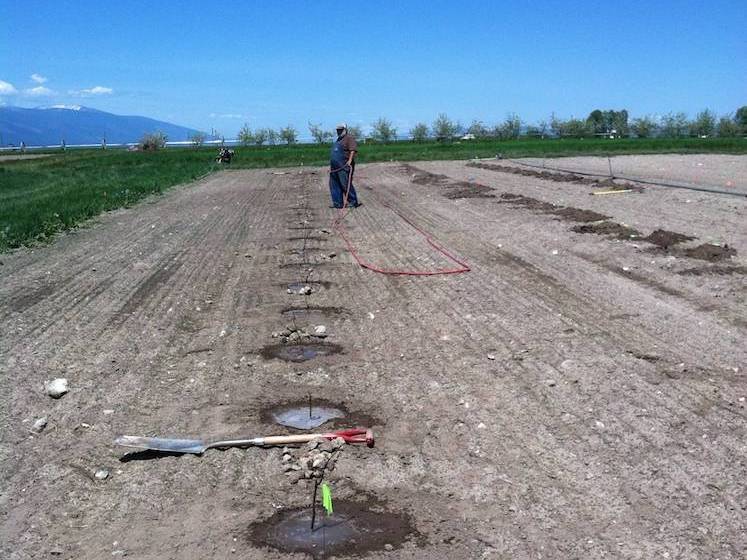Planting and Caring for New Vines
WARC staff keep their new vines safe from the heat by soaking their roots in buckets of water until just before planting.
Once again, Minnesota Grape Grower's Association (MGGA) and University of Minnestoa’s “Growing Grapes in Minnesota” (PDF), in addition to Cornell University's New Vineyard Timeline resourcesoffer a lot of great information for planting and caring for young vines in your vineyard. The MGGA also put together a fantastic video series demonstrating best practices for planting, pruning, and more.
With that said, below are some basic guidelines to follow when planting new vines:
- Most of the cold-hardy grape vines you will find sold at nurseries are “dormant rooted” vines, meaning they were propagated from cuttings during the dormant season, planted in the nursery in spring and allowed to root and grow, then dug up in the fall to be ready for sale the following season. You will likely receive this type of vine “bare root” (rather than planted in a pot). Having the vines shipped in early spring (March/April) is best as it’s cooler and less stressful on vines. Be very careful to keep these roots moist and protected from direct sunlight before planting. While planting, you can keep the vines protected by simply keeping them in a bucket of water.
- Lay out a measuring tape along your row or pre-mark your plant spacing to help ensure properly spaced plantings. It can also be helpful to have a ruler or stick to help you measure from a reference point (e.g. measuring tape or string along the side of the row) to the middle of the row so that you can keep your vines in line with each other and the trellis all the way down the row.
- Vines should be planted in the spring once the soil is workable, but take care to avoid planting when the soil is too wet (sticking to your tools, etc.). Prepare a hole for each vine that is both wide and deep enough to accommodate its entire root system. A good rule of thumb is to dig deep enough to bury 6-8 inches of the vine under the soil.
- When positioning the vine in the hole, use your reference stick or ruler to ensure it’s centered within the row. If the root system on the vine is a bit unruly, you can trim the roots back a bit so that it fits more nicely in the hole (if you have sandy or well-draining soils, be more conservative with this step, as you’ll want to keep as much of the root system as possible). Also, if the cutting portion is longer than ~12 inches, feel free to trim the top down so that you’re only leaving ~6 inches above the ground at planting. Again, a good rule of thumb is to bury all of the roots plus the first 1-2 buds on the cutting, so that there is ~6-8 inches of the vine under soil.
- Before backfilling the hole, untangle and spread out the roots as much as possible. It can also help to mound up the soil a bit underneath the roots, so that they more naturally fall downward.
-
As you’re backfilling, make sure you’re tamping down the soil as you go, which will help to eliminate any air pockets around the roots. Take care to leave a bit of a depression around the vine, as this will help catch and keep rain and irrigation water around the base of the vine.
Newly planted vines need plenty of water at planting!
- And finally, once your vine is snugly tucked into the ground, give it water right away! Add more soil if any roots or air pockets are exposed after the water and soil settles.
- Young vines should continue to receive ~½ to 1 inch of water per week during their first season, which for a 3 x 3 foot area amounts to about 5 gallons of water per plant per week. Refer to the irrigation sectionof this guide for more information on watering your vines as they mature.
Additional Resource: Planting New Vines Prep (VIDEO), Minnesota Grape Growers Association, 2017.
Looking for more information on how to care for your maturing vineyard?
Check out our Vineyard Management Guide!



